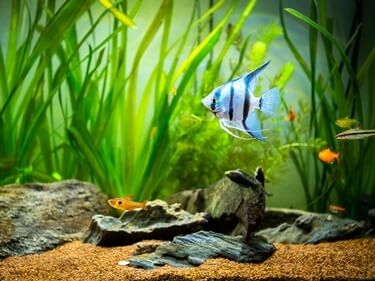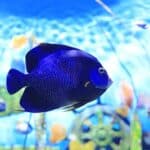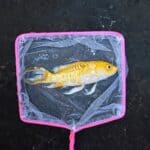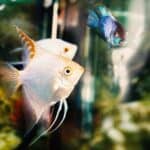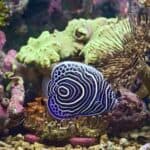Community tanks allow you to mix and match a variety of different fish species and aquarium plants. If you’re trying to find tank mates for your angelfish, that can be difficult. After all, cichlids can be predatory and aggressive. Choosing the right species to pair with angelfish is a delicate process of avoiding fights and creating enough space.
The best tank mates for angelfish are livebearers (platies, mollies, swordfish), certain catfish (Corydoras, Twig, bushynose, and bristlenose plecos), and peaceful cichlids, such as keyhole cichlids, loaches (kuhli and yoyo), and Zebra Danios. Peaceful tetras are also a great pick, like the lemon tetra and the rosy tetra, or algae eaters, like siamese algae eaters, Malaysian trumpet snails, and mystery snails.
You should always avoid fish species that are hostile or territorial in nature. If they’re smaller than your angelfish’s mouth, they’re likely to get eaten. Likewise, if you want a community tank that houses 15+ tank mates, choose a large aquarium. You’ll need a 60-gallon tank at the minimum for this number, while smaller sizes only work for a handful of tank mates.
What Fish Are Good Tank Mates for Angelfish?
The best tank mates for angelfish are those that are:
- The same size as angelfish
- No smaller than an angelfish’s mouth
- Calm and docile
- Swim either high in the tank or low, to avoid angelfish
- Non-confrontational
- Non-territorial
That’s because freshwater angelfish are a type of cichlid. They are aggressive by nature, but can peacefully live with other fish if they’re allowed to maintain their own territory. If any tank mates can respect these areas and do not challenge them, fights are unlikely to break out.
Likewise, angelfish are natural hunters. If they notice fish that are small enough to fit in their mouths, they may be unable to resist the temptation. Always opt for fish that are equal in size to your angelfish. If they must be smaller, they cannot be smaller than the angelfish’s mouth. If they fit, they may be eaten.
Tank mates that are larger than angelfish are acceptable. However, they must not be aggressive or territorial. Angelfish can become the victim of other predatory fish just as easily. If the larger fish keeps to a different tank area, such as the high levels or the bottom, then the two can ignore each other.
Angelfish Compatibility Chart
Let’s explore some tank mates that will be good fits for your angelfish. These range from high, to adequate, to mild compatibility. Then, to help you avoid picking tank mates that will start fights, we’ll cover some that are tentative matches or have no compatibility.
These are broken up on a scale of 1 to 10. This list is not exhaustive, so if your heart is set on a particular fish, feel free to do more research.
High compatibility (10)
These fish will be an ideal fit for your angels.
- Livebearers (Platies, Mollies, Swordtails)
- Certain Catfish (Corydoras, Twig, Bushynose Pleco, Bristlenose Pleco)
- Keyhole Cichlids
- Loaches (Kuhli, Yoyo)
- Peaceful Tetras (Lemon, Rosy)
- Zebra Danios
- Snails (Malaysian Trumpet, Mystery)
Adequate compatibility (8 to 9)
These fish will be happy to get along with your angelfish, so long as the tank is large enough.
- Dwarf Gourami
- Ram Cichlids (German, Bolivian)
- Guppies
- Head and Tail Light Tetras
- Discus Fish
- Siamese Algae Fish
- Parrot Fish
Mild compatibility (6 to 7)
These fish may take time to get use to each other, but they’ll get along fine in the end.
- Kribensis (Rainbow) Cichlids
- Certain Tetras (Rummy Nose, Neon)
- Pygmy Corydoras
Tentative compatibility (3 to 5)
These ones are a risky fit, but angelfish have been known to tolerate them. Keep a very close eye out for fights.
- Cherry Barbs
- Territorial Tetras (Cardinal, Blackskirt)
No compatibility (1 to 2)
These fish are likely to start fights, get eaten, or cause injury to your angelfish. Try to avoid placing them together, unless you have a great deal of experience or a very large tank. Be prepared to lose a few tank mates due to conflict in the early days.
- Aggressive Cichlids (Oscars, Jack Dempseys, Green Terrors, Convict, Flowerhorn, Jaguar, Wolf, Jewel, Banded)
- Betta Fish
- Bucktooth Tetras
- Goldfish
- Tiger Barbs
- Harlequin Rasboras
- Red Tail and Rainbow Shark
- Predators (Silver Arowanas, Peacock Bass, etc.)
- Any shrimp
Can Angelfish Live with Guppies?
Keeping guppies and angelfish together is doable for several reasons. Guppies share a similar diet and water conditions. They grow to be 2 inches max, so it is unlikely that they will intrude on your angelfish’s territory.
Tetras also don’t require large tanks. It is recommended that you have 1 guppy per 2 gallons of water.
However, these fish do reproduce quickly. If you wish to keep guppies and angelfish together in the long run, adjust your aquarium size accordingly.
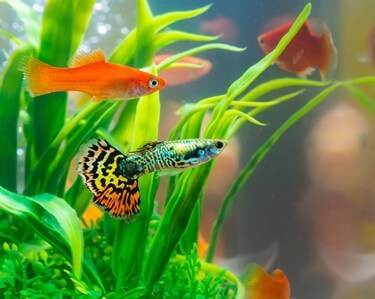
Can Angelfish Live with Mollies?
Mollies are one of many livebearer fish that coexist peacefully with angelfish. That’s because this fish species is peaceful in nature, making them a good match. Mollies and angelfish have similar personalities. As such, you won’t find mollies picking fights with any other tank mate species you choose for your angelfish.
Best of all, mollies are hardy fish. They are very adaptable to water conditions and not picky with their food. This makes them good starter fish for beginners who are new to community tanks. If the worst happens and your angelfish get feisty, mollies are unlikely to get injured. They can protect themselves just fine.
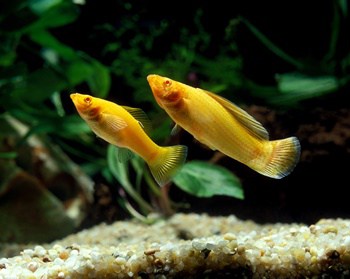
Can Angelfish Live with Parrotfish?
Angelfish and parrot fish share a common family as cichlids. Cichlids are a category of freshwater fish that live in tropical climates. While they’re often observed to be a little mean, some can live quite well together.
Like angelfish, parrotfish like a peaceful community tank. If your exact species of angelfish have docile personalities, aren’t breeding, and haven’t established fixed territories yet, then a parrotfish is a great addition.
The only downside is that parrot fish do not like competing for food and space. This puts them at a risk of being bullied by angelfish, which see them as weaker individuals.
Even still, they can be housed together. Just be sure to provide ample food and room to swim.

Can Angelfish Live with Neon Tetras?
Neon tetras are tentatively compatible with angelfish. This will heavily depend on how many tetras you include in the community tank. Because they only grow up to 1 inch in size, angelfish will be tempted to eat them.
If you choose to house them together, buy a dozen or more, so that the neon tetras can form large schools to avoid predation. A good school size is 15 tetras, with a minimum of 6.
Aside from this, neon tetras can live well in the same environment as angelfish. They require roughly the same water temperature and pH, and consume a similar diet. As a plus, neon tetras are not prone to conflict and inhabit the higher to the tank’s middle area. They will get along with any other tank mates you pick for angelfish.
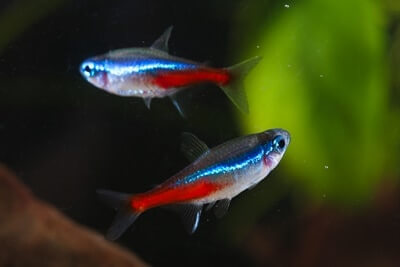
What Algae Eaters Can Live with Angelfish?
Algae-eating fish are a great addition to a community tank. They are docile in nature and can help manage your tank’s algae levels. Several species are effective at cleaning and good friends to angels. These include:
- Mollies
- Twig Catfish
- Bristlenose Pleco
- Siamese Algae Eater
- Malaysian Trumpet Snails
- Mystery Snails
Although mollies are not traditional algae-eaters, they will eat any that’s available. That’s true for many livebearers.
The twig catfish and the bristlenose pleco are both docile fish. They will largely ignore other tank mates and won’t instigate fights with your angels. Do keep in mind their size, however. Both species grow rather large and require a decent amount of swimming room.
Certain aquatic snails make wonderful algae eaters and tank mates. The Malaysian trumpet snail is a good choice, because your angelfish do not see them as prey. Therefore, your territorial angelfish will see them mostly as a decoration, not as food. However, because they are left unbothered, the snails may overrun your tank if allowed to breed unchecked.
Mystery snails are another alternative. This species is larger and more colorful than the trumpet snails. In addition to algae, they also eat fish waste and leftover food.
Bad Tank Mates for Angelfish
As mentioned, the worst tank mates for angelfish are those which are small or aggressive. However, angelfish are also not immune to being bullied. If you pick a larger fish that is aggressive, you may find several fights breaking out. At the worst, the angels will be unable to defend themselves and become injured or killed.
According to the Journal of Fish Biology, there’s a clear link between:
- How aggressive angelfish become and how big their tank mates are
- How often angelfish fight and how much territory is claimed (by themselves or other fish)
Because of that, these upcoming fish species are a poor fit. If you happen to rearrange the aquarium decorations, plants, and gravel, you may confuse the angelfish into being docile. Until they understand where the new territory lines are, they will proceed cautiously. That may help you avoid fights in the coming days.
However, once new lines are drawn, the angelfish may pick fights with any larger fish. This will be in an attempt to either defend territory, or reclaim it. Overall, it’s best to choose more compatible tank mates.
Can Angelfish Live with Goldfish?
Goldfish and angelfish are a pair that isn’t designed to match. Firstly, goldfish prefer colder water temperatures, at around 62 to 72 degrees Fahrenheit. In contrast, angelfish like waters that are 80 to 84.5 degrees Fahrenheit, with only the chilliest saltwater varieties liking 75 or slightly lower. Since goldfish aren’t saltwater creatures, there’s no real way to bridge this gap comfortably.
Aside from that, angelfish are likely to predate on baby goldfish. Even adult goldfish do not sit well with angelfish, because this fish species can grow quite large. This puts your tank at risk for overcrowding.
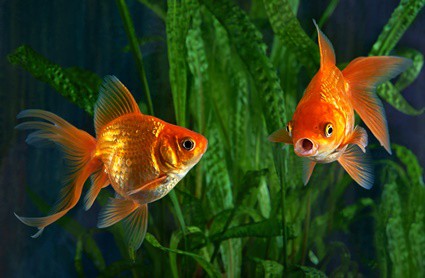
Can Angelfish Live with Red Tail Shark?
Many red tail sharks are aggressive and territorial in nature. This hostility does not match well in an angelfish community tank. While there are some exceptions, it is highly recommended to avoid housing these two together.
Aside from the personality mismatch, red tail sharks prefer living in fast-flowing water. Angelfish do best in gentle currents that do not force them to exhaust themselves.
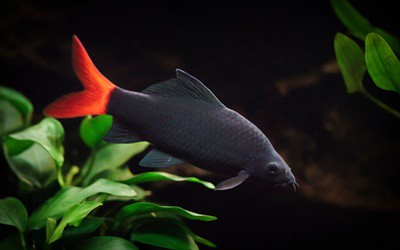
Can Angelfish Live with Shrimp?
Housing shrimp and angelfish together is similar to placing mice near a cat. In fact, angelfish rely on shrimp as a source of food in the wild. In your tank, their instincts will kick in and see your angels hunting down their tank mates without hesitation.
Even if the shrimp is larger than your angelfish’s mouth, the cichlid may pester it via nipping and fights. Your shrimp may then die as a consequence of stress and injuries. Your angelfish will then proceed to pick it apart and eat the pieces.
Never keep angelfish with shrimp. If you want to use the crustacean as live food to keep your angelfish engaged and active, then it’s a great idea. As a tank mate, it’s a poor choice.
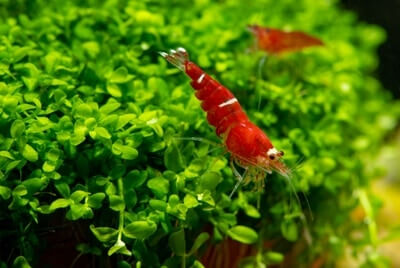
What Fish Can Be Tank Mates With Angelfish?
No matter the tank mate species you choose, the size of the aquarium is crucial. Even very compatible fish will start fights, get bullied by angelfish, or die in a tank that’s too small. Aside from that, you may encounter:
- Overcrowding. Each fish species has its own environmental requirements that allow them to thrive. If they’re packed in together, they will suffer from stress.
- Lack of Hiding Spaces. Even compatible tank mates require space to avoid larger fish or enjoy alone time. A small tank will make them compete for hiding spaces and, as a result, fight.
- Lack of Territory. Angelfish will always try to establish a territory. In small tanks, this may encompass the entire aquarium, causing them to fight with any fish they see.
- No Tank Levels. Angelfish generally inhabit the middle area of the tank. Good tank mates should inhabit the upper or lower levels. In a small aquarium, there won’t be enough space to truly establish levels.
When it comes to stocking your community tank, there is no simple rule to determine how many fish can fit in one tank. The most well-known guess is “1 inch per 1 gallon.” This means that, for every 1 inch of fish, you need 1 gallon of tank size and volume. However, this doesn’t take into account:
- Swimming space for your fish
- Room for aquarium décor
- Space for plants
- Tank filters
- Heaters
As a result, the tank space available tends to be at least 10 to 15% less than advertised. A safer rule of thumb is 1 inch per 2 gallons. To calculate exactly how large your tank should be, let’s explore how large your fish will be at the point of maturity. This allows you to decide on a tank’s size more accurately. Below is a list of:
- Good tank mates
- Their compatibility with your angelfish
- Their respective adult sizes
Keep in mind that these are averages, and some may grow smaller or larger than the given size.
High Compatibility
Most of these have a small size, with only a few reaching a size equal or larger to your angelfish.
- Kuhli Loaches – ¾ inch
- Malaysian Trumpet Snails – 1 inch
- Rosy Tetras -1.5 inches
- Lemon Tetras – 2 inches
- Zebra Danios – 2 inches
- Mystery Snails – 2 inches
- Corydoras Catfish – 2.5 inches
- Platies – 2.8 inches
- Bushynose Pleco – 4 inches
- Bristlenose Pleco – 4 inches
- Mollies – 4.5 inches
- Keyhole Cichlids – 5 inches
- Swordtails – 5.5 inches
- Yoyo Loaches – 5.9 inches
- Twig Catfish – 6 inches
Adequate Compatibility
Most of these stay medium to large sizes.
- Guppies – 1.75 inches
- Head and Tail Light Tetras – 2 inches
- German Ram Cichlids – 2.5 inches
- Dwarf Gouramis – 2.5 inches
- Bolivian Ram Cichlids – 3.5 inches
- Discus Fish – 3.5 inches
- Siamese Algae Fish – 6 inches
- Parrot Fish – 8 inches
Mild Compatibility
These stay much smaller, even in adulthood.
- Pygmy Corydoras – 1 inch
- Neon Tetras – 1.2 inches
- Rummy Nose Tetras -2.5 inches
- Kribensis Cichlids – 5 inches
Up To 40-Gallon Tanks
A tank with a volume of 20 gallons is the bare minimum for housing angelfish. This is because angelfish can grow up to 6 to 12 inches long, including their long fins. If you wish to have multiple angelfish, you should consider a larger tank size, ranging from 30 to 40. Otherwise, you won’t be able to fit many other species inside.
If your goal is to house at least 17 tank mates together, then you have to choose a larger option. A 20-, 30-, or 40-gallon tank will not be enough. At most, you can only have 1 angelfish with a few tiny fish, like tetras.
50-Gallon Tanks
For community tanks with at least 17 tank members, a 50-gallon tank is the minimum size you should aim for. Larger is usually better. This is recommended for several reasons:
- 1 to 2 adult angelfish live best in at least 20 gallons of water
- Many compatible tank mates, on average, require at least 20 gallons of their own water space
- Larger tanks provide enough room for fish, tank filters and heaters, aquarium plants, and décor
55-Gallon Tanks: Recommended Minimum
A 55-gallon tank is the safest bet to start your angelfish community tank. This helps to:
- Avoid overcrowding
- Leave room for ornaments, water filters, and heaters
- Create space for multiple aquarium levels, especially if you pick a tall tank
Additionally, larger tank sizes will help to prevent feeding-related aggression by a wide margin. Feeding-related aggression can occur even if your tank mates are compatible with each other. That’s because food is usually a limiting source for fish. Feeding time can make each species competitive and defensive. According to Frontiers in Behavioral Neuroscience, angelfish analyze:
- The size of their food
- The quantity of food
- The density of that food available
With this, angelfish determine how much energy they should expend to either:
- Reach that food
- Protect that food
With more tank mates, angelfish are more likely to see them as rivals. If the angels eliminate those rivals, they don’t have to worry about a food shortage. This line of thinking can lead to fights, unless you provide them with more space. In a bigger tank, angelfish will calculate that there is enough space and enough food. There is no reason to waste energy fighting others, since they’re not threatened.
Likewise, a bigger tank allows you to distribute the fish food evenly across the whole aquarium. This can help distract the angelfish and encourage them to leave behind other rivals to section off their own feeding area.
Tank Mates for 55-Gallon Tanks
Here are several lists that serve as ideas for stocking your angelfish community tank, starting with less angelfish to more. They all add up to 17.
- 1 angelfish, 8 neon tetras, 6 zebra danios, 2 parrot fish
- 1 angelfish, 2 Siamese algae eaters, 2 pygmy corydoras, 2 mystery snails, 4 guppies, 6 livebearers (platies, mollies, and/or swordtails)
- 2 angelfish, 1 twig catfish, 2 parrot fish, 2 keyhole cichlids, 4 head and tail light tetras, 6 corydoras catfish
- 2 angelfish, 5 livebearers (platies, mollies, and/or swordtails), 4 Malaysian trumpet snails, 4 kuhli loaches, 2 kribensis cichlids
- 4 angelfish, 4 kuhli loaches, 4 tetras (rosy or lemon), 3 mystery snails, 2 ram cichlids (German or Bolivian)
- 4 angelfish, 4 livebearers (platies, mollies, and/or swordtails), 4 guppies, 4 corydoras catfish, 1 bristlenose pleco
Angelfish are kept in even numbers or as singles because they tend to pair off with one another. Odd ones out are usually bullied by paired angelfish. This makes it wise to keep angelfish numbers even or singular to avoid conflict.
Likewise, cichlid populations should match or be lower than the number of angelfish. That’s because cichlids tend to be nippy toward one another. Their temperaments range from peaceful to semi-aggressive. As such, keeping cichlids in this way will help to avoid fights.
60, 70, 80+ Gallon Tanks
Tank sizes greater than 60 gallons allow you a wonderful degree of flexibility. You can pick a wider range of tank mate species and keep several of each kind. You can also choose from larger species, which won’t be forced to fight over space.
The following species will live happily in a tank that’s 60, 70, 80, or more gallons in size. The larger the tank, the more peaceful they will be.
- Many Catfish (Corydoras, Twig, Bushynose Pleco, Bristlenose Pleco)
- Discus Fish
- Parrot Fish
- Yoyo Loaches
Most of all, larger tanks allow your angelfish to claim territory without taking too much tank space away from other fish. They can pick out decorations or areas that suit their tastes. Other fish can then section off their own private spots to hide, explore, and eat at their leisure. If you want to prioritize your angelfish over other fish, you can have something from 6 to even 12 angelfish in one aquarium.
Housing tank mates with angelfish is no easy feat. You need to consider the different fish temperaments and tank requirements. Combining peaceful and decently-sized fish species with your angelfish is key. The larger the tank, the more healthy that environment will be.

